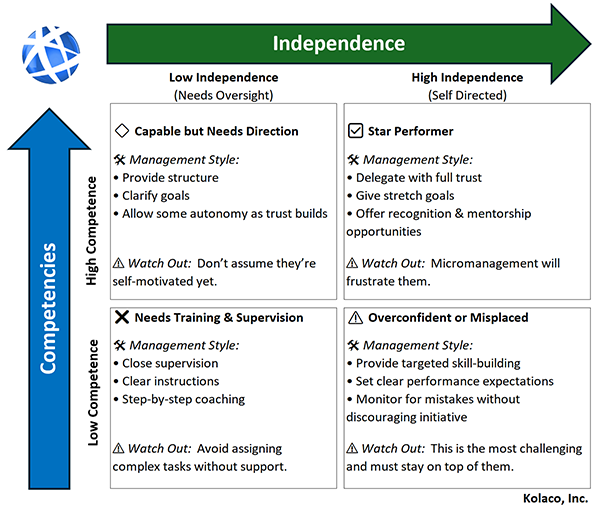
In any organization, your people are your most valuable asset—but they’re not all the same. One of the biggest mistakes leaders make is managing every employee the same way. This cookie-cutter approach leads to disengagement, frustration, and missed potential.
To truly motivate and elevate your team, you need to recognize where each person stands in terms of two crucial qualities: competency and independence. When you understand how these two dimensions intersect, you can unlock performance across the board.
🎯 The Competency vs. Independence Matrix
This matrix helps categorize employees based on:
- Competency – their skill, knowledge, and ability to perform the job well
- Independence – their level of self-direction and need for supervision
These two factors create four employee types—each requiring a unique management style to thrive.
🔻 1. Low Competency, Low Independence
“The Learner”
These individuals are new, inexperienced, or struggling. They require hands-on guidance and ongoing supervision.
How to Manage:
- Provide clear instructions and frequent check-ins
- Use job aids, SOPs, and step-by-step coaching
- Set small, achievable goals to build confidence
Motivational Tip: Celebrate small wins and milestones. Make learning feel like progress, not punishment.
🔷 2. Low Competency, High Independence
“The Eager But Unready”
They want to fly before they’re ready. Their drive is high—but their skills haven’t caught up yet.
How to Manage:
- Give them opportunities to grow—but with a safety net
- Monitor for mistakes without discouraging initiative
- Offer specific feedback and encourage questions
Motivational Tip: Show that you believe in their potential, while also providing the structure they need to succeed.
🟧 3. High Competency, Low Independence
“The Capable Contributor”
They’ve got the skills—but still look to you for guidance or reassurance. They might lack confidence or simply prefer structure.
How to Manage:
- Set clear goals and expectations
- Encourage more decision-making over time
- Provide feedback that builds autonomy
Motivational Tip: Let them know they’re ready for more. Support them in stepping up, not just showing up.
✅ 4. High Competency, High Independence
“The Star Performer”
These are your MVPs. They’re experienced, resourceful, and self-sufficient. Overmanaging them will backfire.
How to Manage:
- Delegate outcomes, not tasks
- Recognize their accomplishments and give stretch projects
- Provide strategic direction, not daily instructions
Motivational Tip: Focus on career development, mentorship, and meaningful challenges. Keep them inspired, not boxed in.
🔑 Why This Matters
Employees disengage when:
- They’re micromanaged despite being capable
- They’re left alone when they need support
- They aren’t challenged enough to grow
- They don’t feel seen for where they are on their journey
Using this matrix to match your management style to each employee’s needs helps you:
- Increase engagement
- Reduce turnover
- Develop future leaders
- Improve team performance
📈 Great Leaders Flex Their Style
Effective leadership isn’t about treating everyone equally—it’s about treating everyone equitably. That means giving each person what they need to succeed at their level.
If you’re a manager, start by mapping your team members on this matrix. Identify where each person falls today—and how you can help them move toward higher competence and independence tomorrow.
Because when you manage people right, they do more than perform—they thrive.
Kolaco has experience implementing performance management systems, employee engagement systems and processes to elevate productivity and employee morale.
